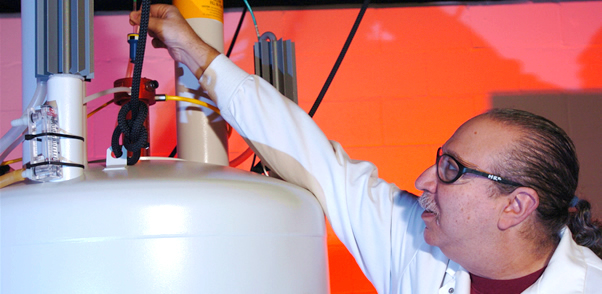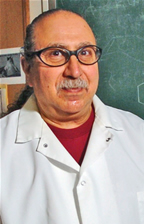| Powerful New Machine Eyes Electrons |
||
|
| NSF Funds Purchase of an Electron Paramagnetic Resonance Spectrometer
Oct. 18, 2007 :: No. 68 A powerfully magnetic instrument that can peer at the electrons orbiting an atom’s nucleus soon will accompany the also powerful Nuclear Magnetic Resonance (NMR) Spectrometer already in a basement laboratory in McCarthy Hall on the Cal State Fullerton campus. The NMR can help determine the structures of molecules by looking at how the nuclei of atoms are interconnected. The new instrument is called an X-band Electron Paramagnetic Resonance (EPR) Spectrometer. It could become a tool for a large group of researchers probing some of the smallest parts of the physical universe. “When we have the new instrument installed and working, we hope to try to make it available to other educational institutions via the Web so they can use it, too,” said Harold Rogers, associate professor of chemistry and biochemistry and the leader in applying for the funding. The NMR at Cal State Fullerton is already being shared. “We already have a number of universities that share equipment that way through CMolS, Rogers said. “With the NMR and EPR being shared, and what is available at other universities, we’re trying to probe the very structure of matter.” CMolS is the W.M. Keck Foundation Center for Molecular Structure at Cal State Fullerton, but is better known as CMolS. Its home is the CSUF Department of Chemistry and Biochemistry. Both the NMR and the EPR are so powerful that no credit cards, ZIP disks, digital photo cards or anything else that depends on magnetic recording can be near them. An instant’s exposure within range of either of the machines’ magnetic fields could destroy the information irretrievably. Each spectrometer will be housed in its own space in a large shielded room that remains locked to anyone not authorized to enter. The EPR was funded by a grant of $339,266 from the National Science Foundation (NSF). It will take about five months for the unit to be built, shipped and installed, said Rogers. The funding includes ancillary items needed to optimize the utility of the EPR, Rogers said, such as an Electron Nuclear Double Resonance (ENDOR) system, a Variable Temperature (VT) unit, optical transmission, dielectric mixing resonators and a programmable goniometer. Rogers, who holds a doctorate in chemistry from the Massachusetts Institute of Technology, explained the equipment: “The ENDOR is an accessory that allows simplification of the electrons’ resonance signals. Think of it as listening only to the violin section of a string quartet playing a Bach piece. The VT unit allows the investigator to conduct experiments at temperatures ranging from liquid nitrogen (-196 C) to about 150 C. Temperature can affect chemical and physical properties. “The optical transmission resonator provides a visual of the material being studied, since the color of the sample can change, much as those cute little blue plastic spoons that children used to get with their breakfast cereal that changed to pink in cold milk,” Rogers said. “The dielectric mixing resonator allows two materials to be mixed so that when they react the intermediate components of the reaction, which can be very, very short-lived, can be observed. The programmable goniometer creates angles — which can be copied exactly later — so that the investigator can observe the changes in the material’s properties as the angle of the instrument’s stream of microwaves pointed at it changes.” Electrons are like compass needles, Rogers explained. In a compass, the needle will point at magnetic north. If it changes, then there is another magnetic field or high-frequency radio waves coming from another direction, and the needle points out where. “In the case of electrons, you check the direction of spin,” he said. “We’ll be able to see how electrons react to magnetic fields, how they behave, what they do differently, what changes. “Depending on the molecule — it has to have an unpaired electron, because paired electrons can’t be observed using this technique — we can put a sample in the NMR to study the properties of the nuclei, then put it in the EPR to get the properties of electrons. We can collect a lot of information that way,” Rogers said. The equipment can have a number of applications. Geologists, volcanologists, medical researchers and a variety of chemists are among those who can use it in their studies. “The mineral hematite is a good example,” he pointed out. “Hematite has lots of iron, and each iron atom has up to five unpaired electrons. Blood also has iron, so the EPR could be used for medical purposes. EPR may also be used for studies of food and beverages, radiation exposure and for pharmaceuticals. “Pharmaceuticals are very good examples. There will be substances that might be studied in the NMR to take a look at the nuclei, their properties and how they react,” the researcher said, “then, in the EPR to take a look at the electrons. You can see what the reactions are on those levels and how the two, the nuclei and the electrons, can relate to each other and to the environment around them.” Rogers, a Westminster resident, said there is yet another use for the new equipment, especially with remote access via the Web. “We can use it to generate excitement about science in the area’s students. For example, we can’t take a machine like this to a high school, but we can allow them to see things remotely, as long as they are supervised. One thing we’re thinking of using as an example sounds simple, but will work really well because it has all the elements needed to show what the machine can do,” said Rogers, grinning. Then, after a pause: “A coffee bean.” Maria Linder, chair and professor of chemistry and biochemistry, sees a great deal of potential with the new instrument, on more than one level. “Acquiring this equipment expands the technical capabilities of our department and increases the range of research our chemists and biochemists can perform,” Linder said. “Previously, some of the faculty who needed this equipment for their research had to go to a neighboring university, such as Caltech. Now that we have our own instrument, that saves a great deal of time and energy. Also, having the instrument in our department expands the possibilities of exposing our students to it and allows us to include its use in our courses. “In addition,” Linder said, “having the instrument will make the department more attractive to future faculty hires.”
|
|

